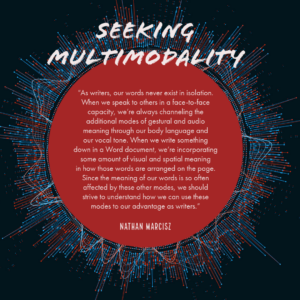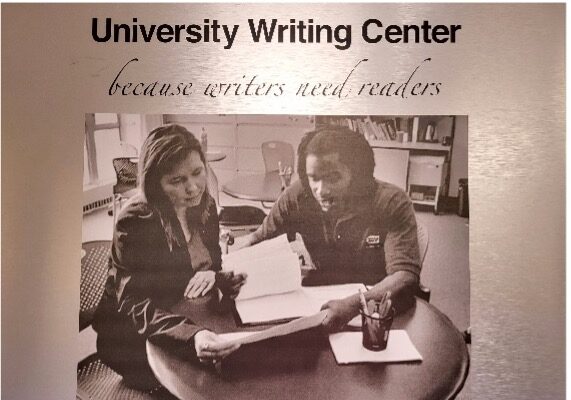
by Nathan Marcisz
Recently, for the W397/597 Writing Center Theory & Practice course, I read Multimodal Composing: Strategies for Twenty-First Century Writing Consultations, a collection of pieces edited by Lindsey A. Sabatino and Brian Fallon about how writing center consultants can speak to multimodal projects that may not be traditionally viewed as “writing projects.” As writing center consultants, we may consider formats like PowerPoint presentations, podcasts, videos, etc., to be beyond the scope of our consulting work, but this need not be the case. Once we accept that all forms of writing are inherently multimodal, it becomes easier for us to accept that these aforementioned projects are ultimately writing projects that we can and should speak to.
But first, what is multimodality? Put simply, when I refer to multimodality, I am referring to how a constructed piece of rhetoric uses multiple modes to communicate meaning. Let’s take an example that we’re probably all familiar with: a printed, physical book. Any book that you can take off of a bookshelf is more than just a stream of words: it is also the visual design of its cover, the tactile materiality of its pages, and the intentional choice of its fonts. All of these elements communicate meaning to the book’s consumer, and these added layers of meaning can either augment or dampen the author’s original intent.
Now, of course, we’ve all heard that we should “never judge a book by its cover.” Whether or not we should does not change the fact that we do, and I’m sure we could all think of examples where books were poorly served by covers which failed to match their tone. Probably the most egregious example that comes to mind for me is this Great Classics edition of Frankenstein featuring a young knight summiting a snow-capped peak; this is an event which, as far as I can recall, happens nowhere in the course of the story.
Just as a physical book can be helped or hampered by its cover, so too can other writing projects be helped or hampered by their different modes. Perhaps, like me, you’ve turned off an otherwise well-written podcast because it had distracting audio mixing. Or perhaps you’ve stayed engrossed in a poorly-written movie because the cinematography and the music were so masterfully executed. Since the effective use of these different modes impacts how the linguistic elements of the project are received, they should be of great concern to the writer.
As writers, our words never exist in isolation. When we speak to others in a face-to-face capacity, we’re always channeling the additional modes of gestural and audio meaning through our body language and our vocal tone. When we write something down in a Word document, we’re incorporating some amount of visual and spatial meaning in how those words are arranged on the page. Since the meaning of our words is so often affected by these other modes, we should strive to understand how we can use these modes to our advantage as writers.
Does this mean that all writers should also be expert visual designers, audio technicians and public speakers? Certainly not! There is only so much time in the day, and often we may find ourselves with barely enough time to tackle our writing responsibilities, let alone trying to learn other media literacies on the side. But having a general understanding of how our multimodal decisions can enhance the meaning of our words is useful, and Multimodal Composing is a resource that I can wholeheartedly recommend for developing such an understanding.

